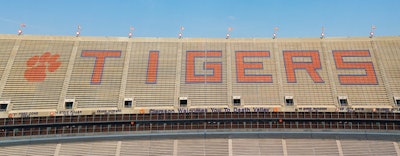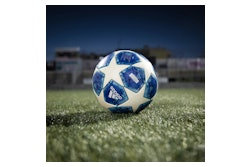
As the world of college athletics looks toward the future, the only certainties are that nothing is certain and that getting back on the field and court will be a long and complex process. In a May 1 press release, NCAA chief medical officer Brian Hainline noted that a return to action will likely look different for every member institution, as the rate of COVID-19 infections differs greatly across the country.
"It is also important to take into consideration that there will not be a quick, single day of re-emergence into society," Hainline said in the statement. "We will re-emerge in a manner that recognizes COVID-19 will be around until there is an effective vaccine, treatment or both. That is why resocialization should be rolled out in a phased way that helps assure sustained low infection spread, as well as aids in the ability to quickly diagnose and isolate new cases."
The NCAA has released a working document titled "Resocialization in Sport" that lays out nine core principles required for the return of athletics, as well as a detailed three-phase plan that the association will follow as it gradually works to ensure a safe and responsible return to competition. Regardless of what that process looks like, the landscape of college sports has changed forever, and fans, athletes and facility operators alike can expect big changes to the game-day experience.
New normal
Drew Pittman is associate athletic director for event management and facilities at Baylor University. He's been looking at various ways to approach the reopening of athletics, considering options that range from playing games in empty stadiums to playing in front of reduced crowds. When COVID-19 has been officially contained in the United States, or a vaccine has been finalized, Pittman says the "new normal" will be anything but.
"When everyone is back in the venue with a variety of new measures to make that work, maybe at that point we call it the post-COVID world," Pittman says. "The scientists haven't quite figured that out yet I guess — if there's actually going to be a post-COVID world or not. This thing may hang out for a long time, maybe even forever."
If that's the case, Pittman and other college athletics professionals are trying to determine exactly what that means for game-day operations. At the most basic level, operators are looking at how to manage stadium and arena congestion points where virus transmission is most likely to occur. If you've been to any college game, some of the time you spend shoulder-to-shoulder occurs in lines — entering the stadium or waiting at the concessions and restrooms.
"We've spent a lot of time thinking about what social distancing means for the lines that get people into our venues — the lines you may have inside your venue, and just general concourse circulation," Pittman says. "Past that we start getting into a lot of different challenges. In the past we've had handheld metal detectors. That's still something we'd be wanting to use, but now we have to figure out what kind of PPE might be necessary for staff and fans waiting in those lines."
Pittman says he's heard discussions around providing guests and venue staff with branded masks. Meanwhile, facilities will likely increase availability of hand sanitizer throughout the building, as well as offering dedicated hand-washing stations in the parking lot, concourses and other areas of the building.
Controlling the perimeter
Just like mitigating the threat of terrorism at athletics venues, the fight to stop the coronavirus begins with controlling the perimeter. The sooner operators can identify anyone who might be sick, the better.
Pittman says that health screening of fans may become a part of the game-day experience for the foreseeable future.
"We've started to look at our current security screening and what it would it look like if we had to add a health screening to that," he says, "and where would we do that?
"Would we do that before fans arrived in the tailgating areas, or maybe we have some corporate activations or tents where there's some pre-game activities? Would we try to do that health screening before those activities, which would traditionally be much farther out than where we do a security screening?"
Recording temperatures could involve everything from visitors passing through medical tents to surveying crowds from above using drones that are equipped with special thermal imaging technology that can detect "hot spots" within a crowd.
But Pittman admits that those health screenings are just the beginning.
"What happens when someone fails that screening?" Pittman asks. "Are we just immediately sending them home? Is there another secondary screening with a health professional? Or is there even the capacity so that you could have rapid testing onsite?"
Virtual queuing
While a lot of the news around how the current pandemic will affect the athletics experience has been negative, Pittman says it's also an opportunity to consider how operators can offer fans both a safer and more enjoyable experience. One way of doing that might be through something that's being called "virtual queuing."
"On the ingress side of how to get people into the venue, we've looked at ways to leverage our in-stadium app and our ticketing system to provide a reservation-type application for folks," Pittman explains. "So maybe on a Monday or Tuesday the week of the game, you get an email or text message with a link and you're then able to go register for what time you want to come in, what gate you want to come in, and then depending on how we do with that, maybe you're able to go ahead and order concessions at that time if you're interested in that."
Pittman says the benefits of this kind of model are many, but most importantly, lines are reduced and physical distancing increases.
"So I know maybe my arrival time for the two-o'clock game is 12:45, and I'd like to have a mobile order for concessions that's ready at 1:15, so that by the time I get my family in their seats, I can go back to the concourse and pick up my order that's ready for me," he says. "So, trying to limit those queues on both fronts in the interest of social distancing, all while providing a better guest experience."
Answers to the current crisis are few and far between, but professionals like Pittman are seeing the pandemic as a learning experience.
"We've already had pandemic-type plans, or been through pandemic-type training, but until you've lived through it, you really don't have an appreciation for how it's going to shape up. And obviously this is very different than any plans we've made for SARS or MERS viruses," he says. "We've learned a lot — all of us have — not just sports facility operators. Is there a new normal? Yeah, but I think there are a lot of good things that will come out of this when we go back to regular operations."
The NCAA's Nine Core Principles for Resocialization of College Sport:1. There must not be directives at the national level that preclude resocialization. 2. State and local authorities must have in place a plan for resocialization. 3. There should be a plan in place at the university/college level for resocialization of students. 4. There must be a plan in place at the university/college level for resocialization of student-athletes within athletics. 5. There must be adequate personal protective equipment for athletics healthcare providers, and there must be sanitizers to manage infection control in all shared athletics space. 6. There must be the ability to assess immunity to COVID-19 at a regional and local level. This could include immunity at the college campus, plus a more focused assessment of herd immunity for athletics teams. 7. There must be access to reliable, rapid diagnostic testing on any individual who is suspected of having COVID-19 symptoms. 8. There must be in place a local surveillance system so that new cases can be identified promptly and isolated, and their close contacts must be managed appropriately. 9. There must be clearly identified and transparent risk analyses in place. Such risk analyses consider issues such as economics, education, restoration of society, and medical risk of sport participation, including COVID-19 infection and possible death. |
This article originally appeared in the June 2020 issue of Athletic Business with the title "Will college sports return to normal, or a whole different ballgame?" Athletic Business is a free magazine for professionals in the athletic, fitness and recreation industry. Click here to subscribe.

































